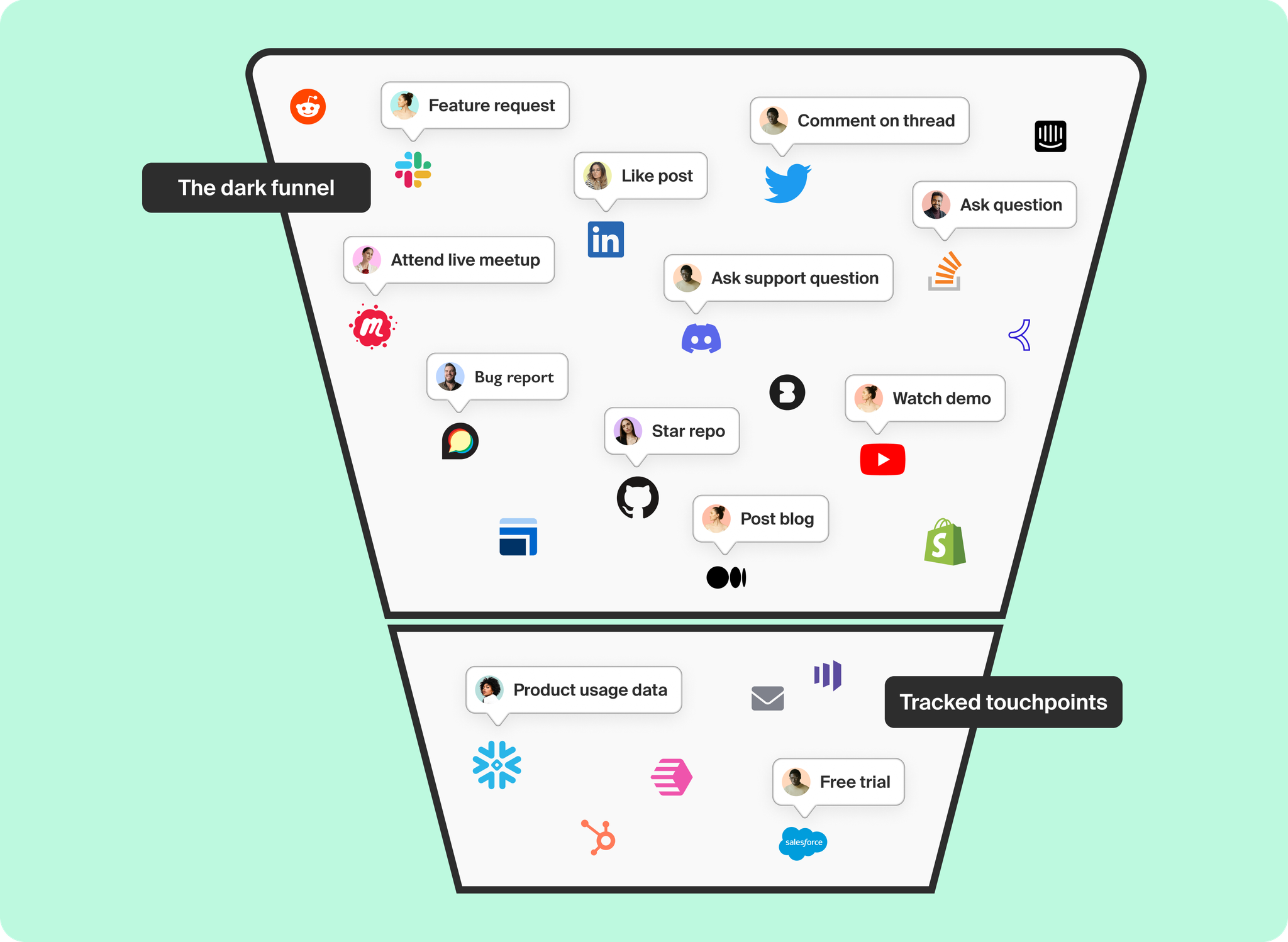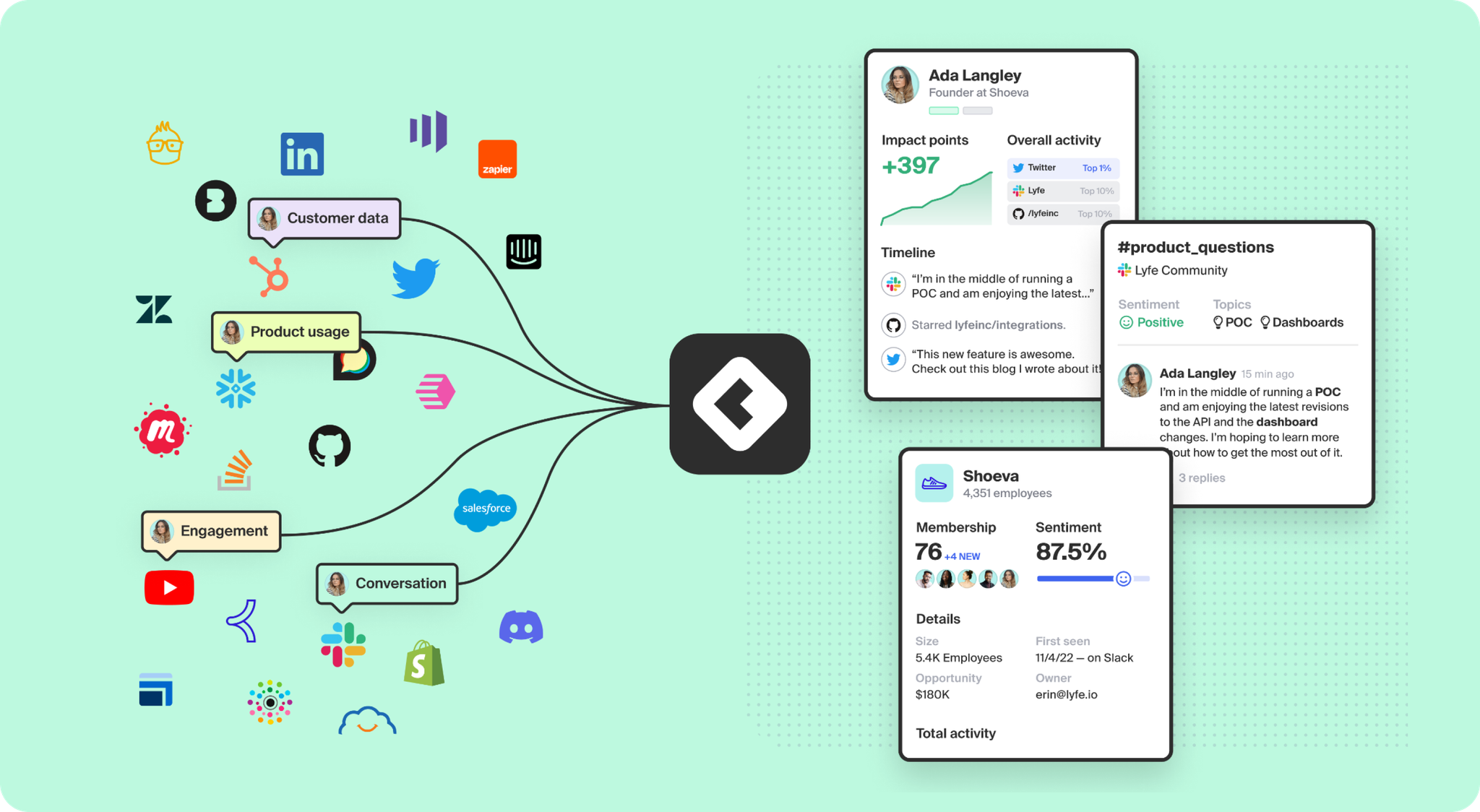Few go-to-market terms sound quite as ominous as “dark funnel.” Then again, few things are quite as helpful when it comes to supercharging your GTM strategy.
Consider this article your primer on all things dark funnel.
We'll explore how to navigate it and dig into:
- What the dark funnel is
- How the dark funnel compares to a traditional funnel
- Examples of channels that make up the dark funnel
- Why the dark funnel can't be ignored
- Software to help you manage the dark funnel
- Tips for engaging with potential customers in the dark funnel
What is the dark funnel?
The dark funnel refers to all the activity customers engage in during the buying journey that you can’t see or attribute.
Think about your last software purchase. Before you landed on a vendor’s website, there’s a good chance you talked to a peer who’s made a similar purchase, searched around various online communities, or put out a call for recommendations on social media (or all three).
Your customers behave the same way. And without the traditional signals to identify, track, and target prospects, you have little-to-no insight into what parts of your GTM efforts are working.
Traditional funnel vs. dark funnel
You’re familiar with the traditional sales funnel. The terminology may change slightly from person to person, but it generally follows the same structure:
| Awareness ➡️ | Interest ➡️ | Evaluation ➡️ | Purchase ➡️ | Retention ➡️ |
|---|
In a perfect world, marketing and sales teams would simply apply their standard strategies to each stage and use behavioral data to optimize over time. Easy enough, right?
In the real world, customers don’t move down the funnel in a straight line. And they certainly don’t do it across owned properties only. They zig and zag into territory where GTM teams can’t follow.
At the end of the day, the dark funnel is very similar to the traditional funnel: The objective of prospects is to get information and make a decision. It just lacks visibility.
Modern customers are conducting research, asking questions, and sharing experiences outside of traditional GTM channels—such as your website—which makes it next to impossible to track them, target them, and engage them.
And the dark funnel is only getting darker. Web browsers such as Google are phasing out third-party tracking cookies and tech giants such as Apple (who hold the keys to tracking at the device level) have limited data access due to privacy concerns. At the same time, government regulations—such as GDPR, CCPA, etc.—are also restricting data access.
Even if data wasn’t becoming more difficult to come by, with the proliferation of devices, customer identities are becoming harder to stitch together. Your average customer is probably researching your product across a range of devices, making it that much trickier to connect John Q. Tablet to John Q. Smartphone.

The dark funnel ecosystem
Listing out each and every dark funnel channel is impossible—more are being added every day. But some of the biggest include:
Community groups
Online community groups hosted on Slack, Discord, and Discourse provide a place for prospective customers to candidly discuss topics related to your product.
Community forums
Online community forums, including Reddit and Stack Overflow, give prospective customers a space to ask questions about products and share their recommendations.
Organic social
Plenty of prospective customers are having conversations relevant to your product without tagging you or commenting on your company accounts.
Dark social
Any traffic-driving communications you can’t track—such as a person copying a link to your website and sharing it via private message instead of hitting the “share” button—qualifies as dark social. Think text messages, emails, and direct messages on social media.
This is by no means an exhaustive list. There are also in-person events, podcasts, publishing platforms, customer service channels, and more to consider.
Long story short, the number of dark funnel channels is only getting bigger.
Why you should embrace the dark funnel
The difference between leaders and laggards is the ability to adapt. Instead of viewing the dark funnel as an insurmountable obstacle, think of it as yet another way to:
Expand your reach
The dark funnel is an opportunity to expand your brand reach beyond typical marketing tactics (SEO, paid advertising, etc.). Casting a wider net means finding more opportunities.
Drive more revenue
Your customers aren’t hiding—they’re just waiting to be found. The dark funnel gives you a way to generate more (and higher-quality) leads, accelerate the buying journey, and close more deals.
Uncover actionable intelligence
Honest feedback makes for better products (not to mention better GTM strategies). The dark funnel represents a wealth of candid opinions from prospects and current customers alike.
At the end of the day, your goal is to have as complete a view as possible of every customer’s journey so you can engage them at the right time and in the right way. That’s what the dark funnel delivers.
Check out our conversation with Ecosystems to see how go-to-market leaders are tackling attribution challenges:
What to do about attribution in the dark funnel
The lack of visibility and attribution infrastructure is what gives the dark funnel its name. Still, many companies have adopted alternative tactics to identify dark funnel leads.
For example, user surveys provide you with insights into how customers discovered your company's products or services. This information can reveal which marketing channels and tactics are worth your time.
And you don’t have to be overly formal about it. Asking users on sign-up pages how they discovered your company or what influenced them to sign up will shed light on the dark funnel.
But at the end of the day, there’s no replacement for purpose-built technology.
Using software to manage the dark funnel
With such a wide range of dark funnel channels, the biggest challenge is integrating so many unique forms of data.
What usually ends up happening is companies find themselves manually combing through a laundry list of channels and corresponding tools. But since visibility into customer activity is siloed to individual channels and platforms, it’s difficult to get a unified view of the dark funnel (not to mention tie top-of-funnel activity to bottom-of-funnel actions).
CDPs, CRMs, ABM platforms (and plenty of other acronym-friendly tools) serve specific purposes, but they’re not built for the dark funnel. They can’t connect all your critical customer touchpoints in a single place, track activity at the user level, or simplify engagement at scale.

What companies need is a tool that allows them to:
Surface which accounts need attention now
Combine all dark and traditional funnel data points into a single source of truth, along with the identity of who’s performing what actions.
Know who to reach out to
Zero in on individuals and their organizations via profile enrichment, identity resolution, segmentation, and filtering to understand prospects and their intent.
Personalize outreach with context
Alert GTM teams to activities from target customers and enable them to automate context-based workflows at the right moment.
Simplify account- and organization-based reporting
Help GTM teams easily leverage relevant data points in the appropriate marketing and sales tools for tracking and performance measurement.

Tips for cultivating leads in dark funnel channels
Here are some tips to help you get started with engaging leads in the dark funnel and converting them into customers:
Know your audience
Conduct research to understand the needs, interests, and behaviors of prospects within your dark funnel. Interview individuals who don’t appear in the traditional funnel to better understand them.
Create valuable content
Provide value to prospects in the form of information, education, incentives, and personalized recommendations to build trust and credibility within dark funnel channels.
Establish your bonafides
Leverage positive reviews, customer success stories, and user-generated content as social proof to deepen trust and credibility.
Personalize content
Strengthen your relationships with prospects by personalizing your messaging and content to their needs and interests based on their behaviors and preferences.
Measure and optimize
Invest in tools that will help you build attribution models and map out customer journeys within the dark funnel so you can understand how prospects interact with your company and identify areas for improvement.
Common Room’s approach to the dark funnel
Common Room brings visibility to your dark funnel, surfacing leads within your community you don't even know are out there. Our real-time data platform sifts through all your digital engagement signals to present targets the instant they become hot. Plus, we signal the organizations and individuals active within your community so you can build relationships with the right people.
With Common Room, your team can track leads across your community and personalize outreach right from the start.
Try Common Room for free today or book a demo. Want to learn more about how community engagement can amplify your sales and marketing efforts? Check out this blog post: Use product-led and community-led growth together for better business outcomes.

